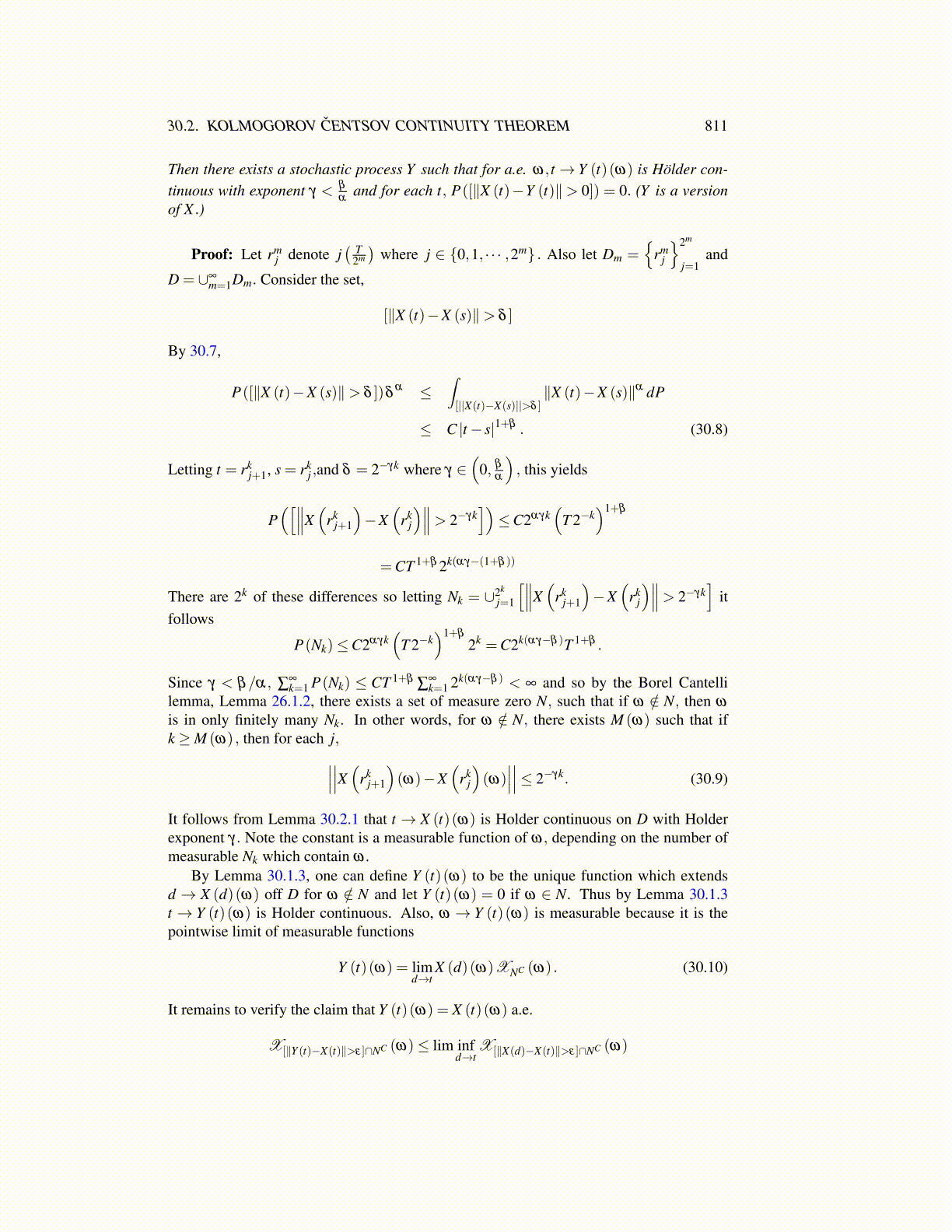
30.2. KOLMOGOROV ČENTSOV CONTINUITY THEOREM 811
Then there exists a stochastic process Y such that for a.e. ω, t → Y (t)(ω) is Hölder con-tinuous with exponent γ < β
αand for each t, P([∥X (t)−Y (t)∥> 0]) = 0. (Y is a version
of X .)
Proof: Let rmj denote j
( T2m
)where j ∈ {0,1, · · · ,2m} . Also let Dm =
{rm
j
}2m
j=1and
D = ∪∞m=1Dm. Consider the set,
[∥X (t)−X (s)∥> δ ]
By 30.7,
P([∥X (t)−X (s)∥> δ ])δα ≤
∫[||X(t)−X(s)||>δ ]
∥X (t)−X (s)∥α dP
≤ C |t− s|1+β . (30.8)
Letting t = rkj+1, s = rk
j ,and δ = 2−γk where γ ∈(
0, β
α
), this yields
P([∥∥∥X
(rk
j+1
)−X
(rk
j
)∥∥∥> 2−γk])≤C2αγk
(T 2−k
)1+β
=CT 1+β 2k(αγ−(1+β ))
There are 2k of these differences so letting Nk = ∪2k
j=1
[∥∥∥X(
rkj+1
)−X
(rk
j
)∥∥∥> 2−γk]
itfollows
P(Nk)≤C2αγk(
T 2−k)1+β
2k =C2k(αγ−β )T 1+β .
Since γ < β/α, ∑∞k=1 P(Nk) ≤ CT 1+β
∑∞k=1 2k(αγ−β ) < ∞ and so by the Borel Cantelli
lemma, Lemma 26.1.2, there exists a set of measure zero N, such that if ω /∈ N, then ω
is in only finitely many Nk. In other words, for ω /∈ N, there exists M (ω) such that ifk ≥M (ω) , then for each j,∣∣∣∣∣∣X (rk
j+1
)(ω)−X
(rk
j
)(ω)∣∣∣∣∣∣≤ 2−γk. (30.9)
It follows from Lemma 30.2.1 that t → X (t)(ω) is Holder continuous on D with Holderexponent γ. Note the constant is a measurable function of ω, depending on the number ofmeasurable Nk which contain ω .
By Lemma 30.1.3, one can define Y (t)(ω) to be the unique function which extendsd → X (d)(ω) off D for ω /∈ N and let Y (t)(ω) = 0 if ω ∈ N. Thus by Lemma 30.1.3t → Y (t)(ω) is Holder continuous. Also, ω → Y (t)(ω) is measurable because it is thepointwise limit of measurable functions
Y (t)(ω) = limd→t
X (d)(ω)XNC (ω) . (30.10)
It remains to verify the claim that Y (t)(ω) = X (t)(ω) a.e.
X[∥Y (t)−X(t)∥>ε]∩NC (ω)≤ lim infd→t
X[∥X(d)−X(t)∥>ε]∩NC (ω)